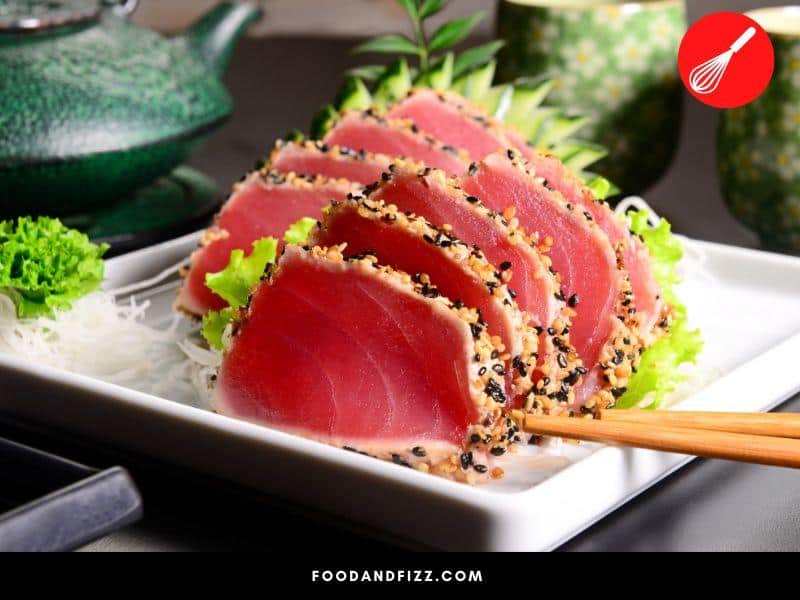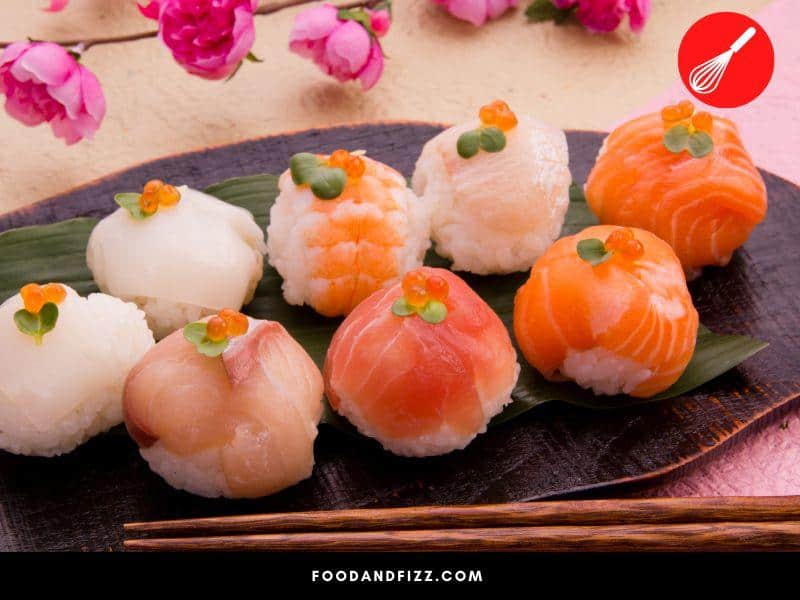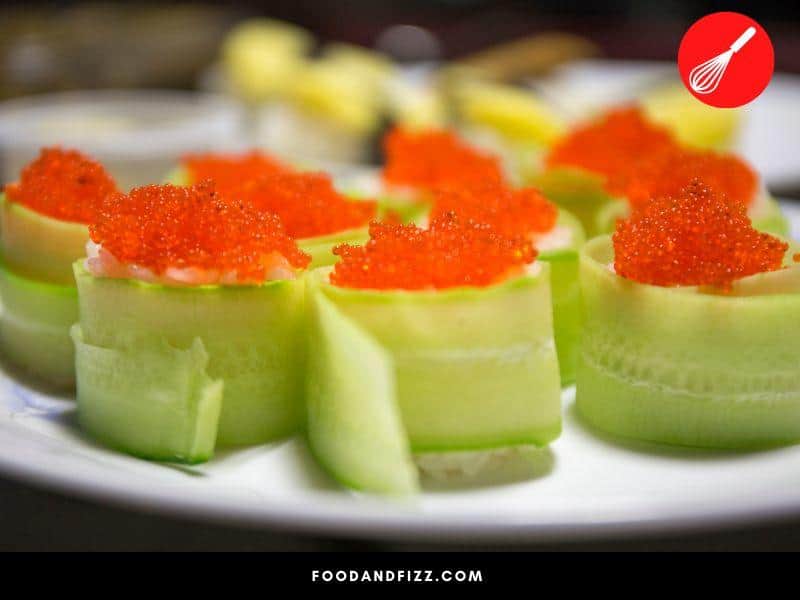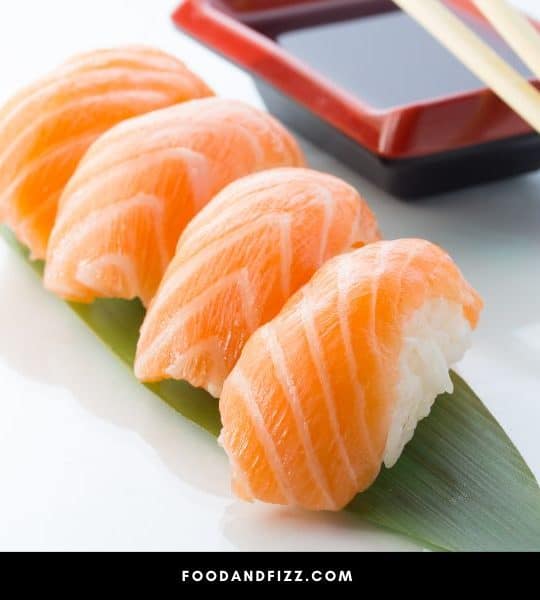When someone mentions sushi, the first words that come to mind for most of us are probably “rice”, “raw”, and “seaweed”. Sushi is all of those things, of course, but that’s only part of the story.
While the sushi of old is primarily raw, there are definitely cooked variations of sushi. While rice is an integral part of its structure, there are actually some types of sushi that are served without it.
And lastly, while seaweed is an iconic sushi ingredient that most of us have come to associate with everyone’s favorite Japanese dish, it surprisingly isn’t there all the time.
So what are these types of sushi specifically? What types of sushi do not feature seaweed as an element?
Types of Sushi Without Seaweed
Types of sushi that do not feature seaweed as an ingredient include sashimi, nigiri, tamagoyaki, chirashi, temarizushi, oshizushi, and inarizushi. Sushi rolls that have been made with seaweed substitutes such as those made with soy or rice paper, cucumber, lettuce, or shiso leaves also do not have seaweed.

Purpose of Seaweed in Sushi
The black-green covering or ribbon-like ingredient that holds sushi together is what is known as “nori”, or seaweed. Nori is actually dried and processed algae. It has a slightly salty, umami flavor that tastes like the sea.
Seaweed is used in sushi for two reasons:
1. To Add Flavor
The smokey, salty flavor profile of nori complements the combination of vinegared rice and raw or cooked seafood. It lends a unique flavor and character to the dish.
2. Holds Sushi Together
Especially for things like maki rolls or temaki hand rolls, the nori or seaweed plays a huge role in keeping everything together and keeping everything compact.
It allows the sushi to keep its shape. In the case of nigiri where sometimes a thin ribbon of nori goes around the sushi, the purpose is to hold together the topping and the vinegared rice.

8 Types of Sushi Without Seaweed
Given its dual purpose, it may seem like nori is an indispensable ingredient in making sushi (when I made my dog’s sushi costume one Halloween, I said that he must have a seaweed belt otherwise he wouldn’t look like authentic sushi!) but the fact is, there are types of sushi that do not feature it at all.
We’ll look at some of those below.
1. Sashimi
Sashimi is thinly sliced raw seafood or cooked seafood. It is served as is, without rice. Because it is “riceless sushi”, it is also seaweed-less sushi as there are no other ingredients that need to be kept together. The quality and flavor of the seafood are the stars of the show.
Some popular types of sashimi include:
- Sake – Raw salmon. Bright orange in color.
- Ahi – Yellowfin tuna. Mild flavor and firm texture.
- Maguro – Bluefin tuna. One of the most highly prized fish in the world
- Ebi – Boiled shrimp or prawns
- Tako – Octopus, can be poached or raw
- Hamachi – Raw yellowtail fish. Often confused with tuna but is actually fattier and some believe, has superior flavor.
- Saba – Japanese mackerel
- Hotate – Scallops, served raw
- Uni – Raw Sea urchin
- Unagi – Freshwater eel, cooked

2. Nigiri
Nigiri is probably the most common image of sushi (and the sushi look I was going for when I made that costume for my dog).
It features raw or cooked seafood (or egg) on top of vinegared rice, with or without a ribbon of nori around it.
Most of the sashimi we mentioned above can be turned into nigiri by just adding a lump of rice. My favorite nigiri is actually very simple, Tamago (Japanese omelet), on a lump of rice. I prefer it with nori but can also have it without.
3. Tamagoyaki
Tamagoyaki is a Japanese egg omelet made by rolling layers of beaten eggs together. It is sweet and custardy and commonly served for breakfast in Japan.
Some versions contain dashi and some versions can even contain seafood. But at its most basic, it is just basically pillows of eggy goodness.
It can be placed on top of vinegared rice nigiri-style or served by itself. Nori or seaweed does not feature in this dish, except when made nigiri-style.
A beginner-friendly recipe for tamagoyaki can be found here.
4. Chirashizushi
Chirashi is essentially a sushi bowl. Vinegared rice is topped with cooked or raw seafood and then sprinkled with other toppings.
It is not that difficult to make at home and can be beginner-friendly. The Japanese word “chirashi” means “scattered”.
However, this does not mean that ingredients are just randomly thrown on top of the rice randomly, like when you throw together a quick dinner bowl in 10 minutes or less.
More often than not, “scattering” means elegantly arranging ingredients so that the beauty of the sushi bowl reflects its delicious taste.
Nori or seaweed in this type of sushi is mostly just used as a topping. You can leave it out of the dish if desired.
5. Temarizushi
This type of sushi is similar to nigiri in that raw or cooked seafood is placed on top of rice, except that temarizushi is in the shape of small balls.
Cooked or raw seafood is common, sprinkled with sesame seeds, but vegetables and fruits like avocado may also be used. Temarizushi can also be intricate and more creative in its designs.
Temarizushi is named after the Japanese Temari ball, an embroidered ball that used to be very popular with kids in Japan. The colorful, varied patterns of the Temari ball are the inspiration for the creative, unique patterns of temarizushi.
As with nigiri, temarizushi may feature seaweed, but it can be made without it.

6. Oshizushi
Also known as “pressed sushi”, oshizushi uses a box or mold to press vinegared rice and other ingredients together to form a “sushi cake” with various layers and shapes. It is not as popular outside of Japan as other sushi dishes.
A unique feature of oshizushi is it often features dried, pickled, and cured ingredients, perhaps because oshizushi is one of the oldest forms of sushi, and in the days when it was invented, it needed to be able to last longer, hence the pickled ingredients.
One type of oshizuhi is what’s called masuzushi, which is pressed sushi made from salted trout pressed on bamboo leaves. It is a popular delicacy in the Toyama prefecture, and can even be found in train stations.
7. Inarizushi
Inari is a type of sushi that has deep-fried tofu or abura-age as a base, cooked and simmered in dashi-broth.
Depending on where it is from, the rice and fillings can be completely covered by the deep-fried tofu or exposed at the bottom or the top to make room for colorful decorative ingredients.
It is named after Inari, who is the Shinto god of agriculture. The earliest forms of inarizushi were offerings to the deities that protected their crops. Inarizushi does not usually feature nori or seaweed as a main ingredient.
8. Sushi made with Nori Substitutes
While maki rolls or temaki hand rolls typically use nori or seaweed as an outside covering, they can be made with seaweed substitutes like rice paper, soybean paper, and tofu skin or yuba.
Sushi rolls can also be made with vegetables like thinly sliced cucumber, lettuce or shiso leaves. There may of course be flavor and texture differences, but the basic idea of rolling vinegared rice with toppings or fillings will be the same.
Thus, sushi rolls can be seaweed-free if made with any of these nori substitutes.

Conclusion to Types of Sushi Without Seaweed
Seaweed may be closely associated with sushi but there are still types of sushi where nori or seaweed is not used.
Sashimi, certain types of nigiri, tamagoyaki, temarizushi, chirashizushi, oshizushi, inarizushi, and sushi made with seaweed substitutes are just some examples.
If you do not enjoy the taste of seaweed or otherwise cannot have it, you can still have an authentic sushi experience by choosing any one of the seaweed-free types of sushi available.
Frequently Asked Questions to Types of Sushi Without Seaweed
Can I Use Rice Paper Instead of Seaweed in Sushi Rolls?
You may use rice paper as a substitute for seaweed when making sushi. Other good substitutes include soybean paper and tofu skin. The flavor profile of course will be different as seaweed has a distinct flavor, but for holding the sushi together, those substitutes will work out well.
Is Seaweed Used in All Kinds of Sushi?
Not all kinds of sushi feature seaweed. Sashimi, some types of nigiri, temaki sushi, chirashi sushi, inari sushi, and oshizushi can all be made without the use of nori or seaweed.
What is Nori?
Nori is the Japanese name for the black-green seaweed commonly used in sushi preparations. It has a smokey, salty flavor.

